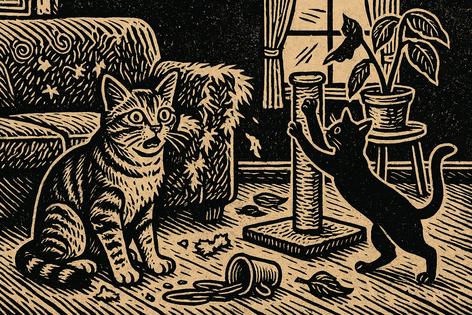Taming the terror or how to deal with a destructive indoor cat
Published in Cats & Dogs News
Indoor cats can be affectionate companions, but without enough stimulation and structure, they can also become surprisingly destructive. From shredded furniture to overturned water glasses and relentless nighttime zoomies, even the most charming feline can develop habits that frustrate their owners. The key to reducing this behavior lies in understanding a cat’s needs and giving them appropriate outlets for their natural instincts.
Cats are hardwired to stalk, pounce and explore, even if their environment doesn’t include mice or open fields. When confined to indoor spaces, especially smaller apartments or homes without much variation, they may turn their energy toward less desirable activities. Scratching furniture, climbing curtains and batting at anything that moves are all expressions of boredom or unspent energy.
The first step in curbing these tendencies is to offer alternative forms of enrichment. Scratching is an essential behavior for cats, not just for sharpening claws but for stretching and marking territory. Owners should provide multiple scratching surfaces throughout the home, such as vertical posts, horizontal pads and cardboard loungers. It may take some trial and error to find the texture and shape a cat prefers, but once they have a favorite, they’ll often return to it.
Interactive play is also crucial. Toys that mimic prey, such as feather wands or laser pointers, allow cats to engage in hunting behavior in a safe and satisfying way. Scheduled play sessions can reduce nighttime hyperactivity and strengthen the bond between cat and owner. Puzzle feeders or treat-dispensing toys offer mental stimulation, encouraging cats to work for their food in a way that echoes their wild ancestors’ routines.
Environmental changes can also help. Cats enjoy vertical spaces, so providing access to high perches or window hammocks gives them a place to observe and relax. Rotating toys or creating cardboard box forts can add novelty to their day. A bored cat is more likely to act out, so changing things up keeps them curious and engaged.
Sometimes, destructive behavior stems from anxiety. Changes in the household, such as new pets, visitors or even rearranged furniture, can trigger stress. In these cases, offering consistent routines, quiet retreat areas and pheromone diffusers can help reduce anxiety. If the behavior continues despite these efforts, a consultation with a veterinarian or animal behaviorist may be necessary to rule out medical issues or to develop a more tailored behavioral plan.
Ultimately, most destructive indoor cat behavior isn’t about malice or mischief—it’s about unmet needs. By observing a cat’s habits, providing enriching alternatives and staying consistent, owners can redirect that energy into healthier, more harmonious routines. A well-stimulated cat is usually a well-behaved cat, and a little planning can go a long way toward keeping both furniture and feline in good shape.
========
This article was created, in part, utilizing AI tools.









Comments